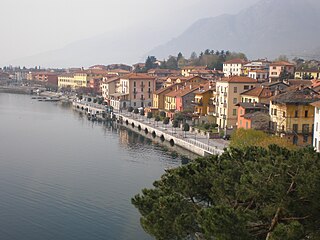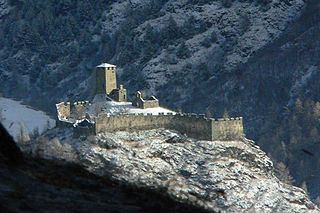
Romanesque architecture is an architectural style of medieval Europe characterized by semi-circular arches. There is no consensus for the beginning date of the Romanesque style, with proposals ranging from the 6th to the 11th century, this later date being the most commonly held. In the 12th century it developed into the Gothic style, marked by pointed arches. Examples of Romanesque architecture can be found across the continent, making it the first pan-European architectural style since Imperial Roman architecture. The Romanesque style in England and Sicily is traditionally referred to as Norman architecture.

Ascoli Piceno is a town and comune (municipality) in the Marche region of Italy, capital of the province of the same name. Its population is 45,630 but the urban area of the city has more than 93,000.

Nibbiola is a comune (municipality) in the Province of Novara in the Italian region Piedmont, located about 80 kilometres (50 mi) northeast of Turin and about 10 kilometres (6 mi) southeast of Novara.
Montemagno is a comune (municipality) in the Province of Asti in the Italian region Piedmont, located about 50 kilometres (31 mi) east of Turin and about 13 kilometres (8 mi) northeast of Asti. As of 31 December 2010 it had a population of 1,228 and an area of 15.9 square kilometres (6.1 sq mi).

Gravedona ed Uniti is a comune (municipality) in the Province of Como in the Italian region Lombardy, located about 80 kilometres (50 mi) north of Milan and about 40 kilometres (25 mi) northeast of Como.
Cesa is a comune (municipality) in the Province of Caserta in the Italian region Campania, located about 15 kilometres (9 mi) north of Naples and about 14 kilometres (9 mi) southwest of Caserta.

The Basilica of Sant'Ambrogio is an ancient Romanesque-style, Roman Catholic church in the center of Milan, region of Lombardy, Italy.
San Vittore may refer to:

Genga is a town and comune of province of Ancona in the Italian region of the Marche, on the Sentino river about 7 kilometres (4 mi) downstream and east of Sassoferrato and 12 kilometres (7 mi) north of Fabriano.

The Castle of Graines is a castle in Val d'Ayas, located near the village with the same name in the municipality of Brusson, Aosta Valley, northern Italy.

Vittore Grubicy de Dragon was an Italian painter, art critic and art gallery owner who was largely responsible for introducing into Italian painting the optical theories of Divisionism. His writings and paintings influenced a generation of late 19th-century Italian painters. In addition, the Grubicy Gallery became one of the first art enterprises to be run on the concept of exhibiting living artists that were represented as clients of the gallery.

Santa Maria in Calanca Castle is a tower in the municipality of Santa Maria in Calanca of the Canton of Graubünden in Switzerland. It, along with the neighboring Church of the Assumption of St. Mary, are both Swiss heritage sites of national significance.

The Sermon of Saint Stephen is an oil-on-canvas by Italian artist of the Venetian school Vittore Carpaccio, painted in 1514. It is now in the Louvre in Paris.

The Miracle of the Cross at the Ponte di Rialto, also known as The Healing of the Madman, is a painting by Italian Renaissance artist Vittore Carpaccio, dating from c. 1496. It is now housed at the Gallerie dell'Accademia in Venice.

Piazza d'Aracoeli is a square of Rome (Italy), placed at the base of the Capitoline Hill, in the Rione X Campitelli.

San Vittore is a parish church of the Roman Catholic Archdiocese of Milan in Esino Lario, Province of Lecco, Italy. It is located on a rocky outcrop and is dedicated to Victor Maurus, who died circa 303 in Milan.

Pala Castle is a tower in the municipality of San Vittore of the Canton of Graubünden in Switzerland. It is a Swiss heritage site of national significance.















